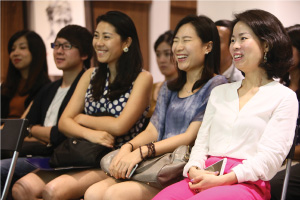NEWS & EVENTS > NEWS
"A nation's culture resides in the hearts and in the soul of its people"
-Mahatma Ghandi
Hide and Seek: Uncovering the Secrets of Chinese Culture with Lin Xi
8 June 2015
In his talk given at Chinese Cultural Studies Center, award-winning lyricist Lin Xi shares his own personal experiences and reflections on what it means to engage meaningfully with Chinese culture, as encountered in art and Chinese antiques.
8 June 2015
In his talk given at Chinese Cultural Studies Center, award-winning lyricist Lin Xi shares his own personal experiences and reflections on what it means to engage meaningfully with Chinese culture, as encountered in art and Chinese antiques.
As part of Asia Week Hong Kong 2015, Chinese Cultural Studies Center hosted a talk over the weekend on June 5, by Lin Xi, award-winning lyricist that is behind some of the most well-known songs of Hong Kong's star singers such as Faye Wong, Leslie Cheung, Andy Lau, and Miriam Yeung. Renowned in both mainland China and Hong Kong, and a name that young and old both seem to recognize, Lin Xi has also penned the lyrics to the song "Beijing Welcomes You," a six-minute song performed for the 2008 Beijing Olympics by a panoply of popular Chinese singers, which proved explosive in popularity in China.
Perhaps it's the same nature that can grasp nuances of meaning in language to create meaningful lyrics that also makes Lin Xi inquisitive and actively reach for deeper understanding in other areas of life that other people by comparison may only passively or reactively engage with. One such area is his engagement with Chinese culture, and the various influences and products of it that are seen around us every day. A recurring theme of his talk—as shown by the examples he gives from his own life—is the reminder to always keep a sense of enquiry and curiosity about the cultural traditions that have been passed on to us, and what we in turn will decide to pass on.
Lin Xi is a thoughtful collector of various Chinese antiques, and while some of his purchases may have been impulsive (such as his purchase of a Tang Dynasty Buddha head, that he bought because it was "instinctively handsome") he takes the time afterwards to ask questions of the pieces. Lin Xi is fascinated with what each piece has to tell about how our ancestors arranged their world, and the life views espoused in their designs:
"Take Chinese furniture, for example. Maybe it's so much more ergonomic and convenient to use a modern office chair today when practicing your calligraphy—you could roll from one end of the long table to the other—but there's something about using those old wooden Chinese chairs that gives the whole experience a different feeling. These old chairs are heavy and hard to move, but think of the focus that it gave the Chinese scholar when he was engaged in his studies and calligraphy. They weren't pushing their chair back every minute to get a drink, go to the bathroom…I think the weight of all the furniture around them gave an air of steadiness and concentration to whatever they were doing. I think this idea of setting a deliberate pace for all their activities was something our ancestors consciously incorporated into the arrangement of their world around them, including their furniture."
Perhaps it's the same nature that can grasp nuances of meaning in language to create meaningful lyrics that also makes Lin Xi inquisitive and actively reach for deeper understanding in other areas of life that other people by comparison may only passively or reactively engage with. One such area is his engagement with Chinese culture, and the various influences and products of it that are seen around us every day. A recurring theme of his talk—as shown by the examples he gives from his own life—is the reminder to always keep a sense of enquiry and curiosity about the cultural traditions that have been passed on to us, and what we in turn will decide to pass on.
Lin Xi is a thoughtful collector of various Chinese antiques, and while some of his purchases may have been impulsive (such as his purchase of a Tang Dynasty Buddha head, that he bought because it was "instinctively handsome") he takes the time afterwards to ask questions of the pieces. Lin Xi is fascinated with what each piece has to tell about how our ancestors arranged their world, and the life views espoused in their designs:
"Take Chinese furniture, for example. Maybe it's so much more ergonomic and convenient to use a modern office chair today when practicing your calligraphy—you could roll from one end of the long table to the other—but there's something about using those old wooden Chinese chairs that gives the whole experience a different feeling. These old chairs are heavy and hard to move, but think of the focus that it gave the Chinese scholar when he was engaged in his studies and calligraphy. They weren't pushing their chair back every minute to get a drink, go to the bathroom…I think the weight of all the furniture around them gave an air of steadiness and concentration to whatever they were doing. I think this idea of setting a deliberate pace for all their activities was something our ancestors consciously incorporated into the arrangement of their world around them, including their furniture."
Page 1 | 2
Related Links:
INTERVIEW:
Bovey Lee-Cut Paper Artist
May 2015
PRESENTATION TRANSCRIPT:
Tang Dynasty Incense Tradition
5 May 2015
PRESENTATION TRANSCRIPT:
Han Dynasty Incense Tradition
5 May 2015
Bovey Lee-Cut Paper Artist
May 2015
PRESENTATION TRANSCRIPT:
Tang Dynasty Incense Tradition
5 May 2015
PRESENTATION TRANSCRIPT:
Han Dynasty Incense Tradition
5 May 2015


